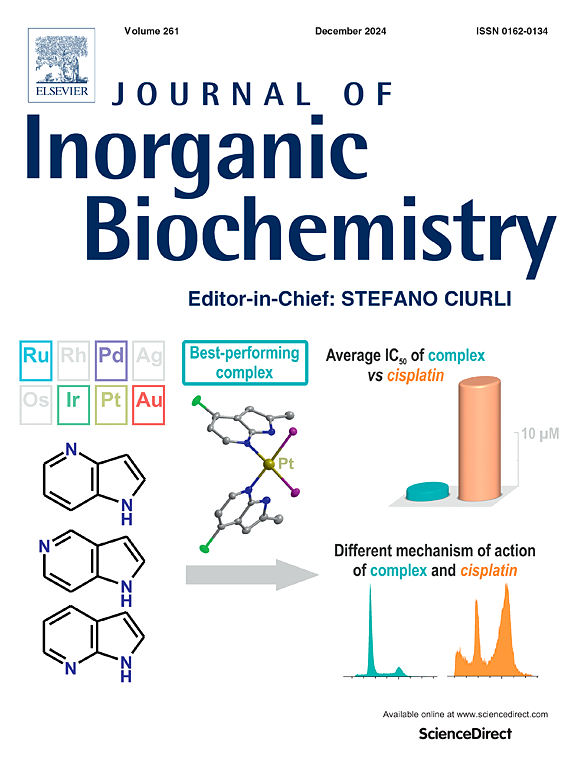Cobalt complexes as modulators against amyloid-β aggregation
IF 3.2
2区 化学
Q2 BIOCHEMISTRY & MOLECULAR BIOLOGY
引用次数: 0
Abstract
The progressive aggregation of amyloid-β (Aβ) peptides is central to the development of Alzheimer's disease, contributing to memory loss, cognitive decline, and neuronal degeneration. Transition metal complexes, owing to their tunable oxidation states and diverse coordination geometries, have been explored as chemical modulators to disrupt the aggregation pathways of Aβ peptides. Their biological applications, however, are often constrained by inherent toxicity and potential metal release. Herein, we report the selection and preparation of cobalt complexes with macrocyclic 1,4,8,11-tetraazacyclotetradecane (Cyclam) and 1,8-dimethyl-1,4,8,11-tetraazacyclotetradecane (DMC) ligands, [Co(Cyclam)(NO3)](NO3), [Co(Cyclam)(Cl)2]Cl, [Co(DMC)(H2O)2](NO3)2, and [Co(DMC)(Cl)2]Cl, adopting either trans-III or cis-V geometry as relatively stable chemical reagents for controlling the assembly and toxicity profiles of Aβ peptides. Our mechanistic investigations reveal that these cobalt complexes can form adducts with Aβ peptides and, subsequently, redirect their aggregation pathway away from the canonical on-pathway process towards the formation of amorphous clusters and shorter fibrils. Furthermore, cobalt complexes mitigate Aβ-induced toxicity with minimal intrinsic toxicity in living cells. Overall, our study illustrates a guidance for selecting metal complexes as chemical modulators against Aβ amyloidogenesis by integrating the characteristics of both metal centers and ligand scaffolds.

钴配合物作为淀粉样蛋白-β聚集的调节剂
淀粉样蛋白-β (Aβ)肽的进行性聚集是阿尔茨海默病发展的核心,导致记忆丧失、认知能力下降和神经元变性。过渡金属配合物由于其可调节的氧化态和不同的配位几何形状,已被探索作为化学调节剂来破坏Aβ肽的聚集途径。然而,它们的生物学应用往往受到固有毒性和潜在金属释放的限制。本文报道了以大环1,4,8,11-四氮杂环十四烷(Cyclam)和1,8-二甲基-1,4,8,11-四氮杂环十四烷(DMC)为配体的钴配合物的选择和制备,[Co(Cyclam)(NO3)](NO3), [Co(Cyclam)(Cl)2]Cl, [Co(DMC)(H2O)2](NO3)2和[Co(DMC)(Cl)2]Cl,采用反式iii或顺式v的几何结构作为相对稳定的化学试剂来控制Aβ肽的组装和毒性谱。我们的机制研究表明,这些钴配合物可以与Aβ肽形成加合物,并随后将其聚集途径从典型的通路上过程转向形成无定形团簇和更短的原纤维。此外,钴配合物在活细胞中以最小的内在毒性减轻a β诱导的毒性。总之,我们的研究阐明了通过整合金属中心和配体支架的特性来选择金属配合物作为抗β淀粉样蛋白形成的化学调节剂的指导。
本文章由计算机程序翻译,如有差异,请以英文原文为准。
求助全文
约1分钟内获得全文
求助全文
来源期刊

Journal of Inorganic Biochemistry
生物-生化与分子生物学
CiteScore
7.00
自引率
10.30%
发文量
336
审稿时长
41 days
期刊介绍:
The Journal of Inorganic Biochemistry is an established international forum for research in all aspects of Biological Inorganic Chemistry. Original papers of a high scientific level are published in the form of Articles (full length papers), Short Communications, Focused Reviews and Bioinorganic Methods. Topics include: the chemistry, structure and function of metalloenzymes; the interaction of inorganic ions and molecules with proteins and nucleic acids; the synthesis and properties of coordination complexes of biological interest including both structural and functional model systems; the function of metal- containing systems in the regulation of gene expression; the role of metals in medicine; the application of spectroscopic methods to determine the structure of metallobiomolecules; the preparation and characterization of metal-based biomaterials; and related systems. The emphasis of the Journal is on the structure and mechanism of action of metallobiomolecules.
 求助内容:
求助内容: 应助结果提醒方式:
应助结果提醒方式:


